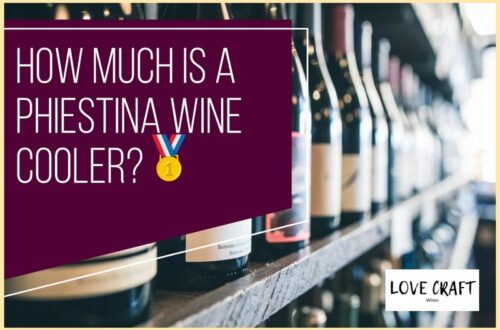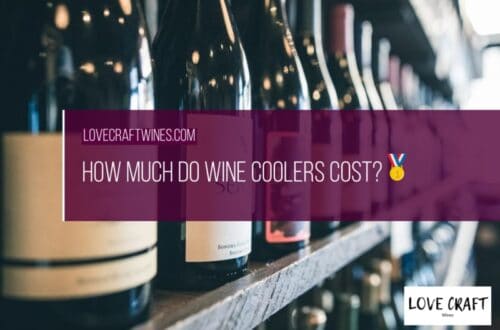You’re ready for a night out with friends, and you’ve decided to indulge in some wine coolers. They’re a refreshing and fruity way to enjoy alcohol, but do you know how many it takes to get drunk? The answer isn’t as straightforward as you might think.
Alcohol content, body weight, and metabolism all play a role in how much it takes to get intoxicated. Understanding these factors can help you make more informed decisions about your drinking habits and stay safe while having fun.
In this article, we’ll explore the science behind wine coolers and intoxication, give you tips for responsible drinking, and help you recognize the signs of alcohol poisoning.
So grab a drink (or don’t, if you’re the designated driver), and let’s dive in.
Table of Contents
Understanding Alcohol Content in Wine Coolers
Understanding the alcohol content in wine coolers can shed light on how consuming them may affect your level of intoxication. Wine coolers are a popular alcoholic beverage choice due to their sweet flavors and low alcohol content compared to other alcoholic beverages.
The alcohol content in wine coolers can vary depending on the brand and flavor, but on average, they contain between 4% to 7% alcohol by volume (ABV). Popular wine cooler brands such as Mike’s Hard Lemonade, Smirnoff Ice, and Bartles & Jaymes contain 5% ABV, while some wine coolers can contain up to 8% ABV.
It is important to note that the alcohol content in wine coolers can be deceiving, as the sweet flavors can mask the alcohol taste and make it easier to consume more than intended. Other factors such as body weight, gender, and tolerance levels can also affect how many wine coolers it takes to get drunk.
Factors that Affect Intoxication Levels
Factors such as body weight, food intake, gender, and rate of consumption can all affect the level of intoxication a person experiences from drinking wine coolers.
Body weight plays a significant role as the more a person weighs, the more fluid it takes to dilute the alcohol content of a drink, leading to a lower blood alcohol concentration (BAC).
Women tend to have a higher BAC than men after consuming the same amount of alcohol due to differences in body composition.
Food intake can also slow down the absorption of alcohol into the bloodstream, allowing the liver more time to metabolize it.
The rate of consumption can also impact how drunk a person gets, as drinking wine coolers too quickly can cause the BAC to rise rapidly. This can lead to feelings of dizziness, confusion, and disorientation.
It’s crucial to be aware of these factors and to drink responsibly to avoid over-intoxication. In the next section, we’ll discuss how to calculate your personal limit and make informed decisions about drinking.
Calculating Your Personal Limit
To figure out your own drinking limit, it’s important to know your body weight, food intake, and how quickly you’re consuming alcohol. Alcohol consumption affects each person differently, and there is no set number of drinks that will get everyone drunk.
To calculate your personal limit, the key factor to consider is your blood alcohol concentration (BAC), which is the amount of alcohol in your bloodstream. To determine your BAC, you can use an online calculator or a BAC chart. These tools take into account your weight, the number of drinks consumed, and the time it took to consume them.
Keep in mind that your BAC can vary based on factors such as gender, age, and metabolism. In general, a BAC of 0.08% is considered legally drunk in the United States. However, it’s important to note that even a lower BAC can impair your judgment and coordination, and increase the risk of accidents and injuries.
Now that you know how to calculate your drinking limit, it’s important to practice responsible drinking. This means pacing yourself, drinking water between drinks, and avoiding excessive drinking. It’s also important to never drink and drive, and to always have a designated driver or alternative transportation arranged.
By following these tips, you can enjoy alcohol in moderation and minimize the risks of harm to yourself and others.
Tips for Responsible Drinking
You can make the most of your drinking experience by following these tips for responsible drinking. Drinking etiquette is important to keep in mind when consuming alcohol in social situations.
It’s okay to decline a drink or pace yourself, even if others are pressuring you to keep up. Remember that it’s your body and your choice. Additionally, always have a designated driver or plan for transportation before you start drinking.
And finally, drink water in between alcoholic beverages to stay hydrated and avoid overconsumption. When it comes to responsible drinking, it’s important to recognize the signs of alcohol poisoning and know when to seek help.
If you or someone else is experiencing symptoms such as confusion, vomiting, seizures, or difficulty breathing, it’s time to seek medical attention immediately. Don’t wait until it’s too late to get help.
Remember that responsible drinking means enjoying alcohol in moderation and being aware of your own limits. By following these tips, you can have a safe and enjoyable drinking experience.
When to Seek Help: Signs of Alcohol Poisoning
If you’re drinking alcohol, it’s important to know the signs of alcohol poisoning so that you can stay safe and enjoy your night out without putting yourself or others in danger – and don’t worry, seeking help isn’t as embarrassing as you might think.
Recognizing symptoms of alcohol poisoning can be difficult, but it’s important to be aware of them. The symptoms include confusion, vomiting, seizures, slow breathing, low body temperature, and blue or pale skin.
If you or someone you know is experiencing these symptoms after drinking, it’s important to seek emergency response immediately. Alcohol poisoning is a serious condition that can be life-threatening, so it’s important to take it seriously.
If left untreated, it can lead to coma or even death. It’s important to remember that there is no shame in seeking help if you or someone you know is experiencing alcohol poisoning.
If you suspect that someone has alcohol poisoning, call 911 immediately and stay with them until medical help arrives. It’s better to be safe than sorry when it comes to alcohol poisoning, so always err on the side of caution.
Frequently Asked Questions
What are the legal drinking age requirements for consuming wine coolers?
If you’re wondering about the legal drinking age requirements for consuming wine coolers, it’s important to note that they vary by location.
In the United States, for example, the legal drinking age is 21. It’s also worth noting that wine coolers can have varying levels of alcohol content, depending on the brand and flavor.
When compared to other alcoholic beverages, such as beer or wine, wine coolers generally have a lower alcohol content. However, it’s still important to drink responsibly and in accordance with local laws and regulations.
How long does it take for wine coolers to be fully metabolized by the body?
When you consume wine coolers, your body’s metabolism rate plays a crucial role in how long it takes to fully metabolize them.
The metabolism rate varies for each individual, but on average, it takes about one hour for the body to metabolize one standard drink.
This means that if you consume multiple wine coolers within a short period, your blood alcohol levels will increase rapidly, leading to impaired judgment, coordination, and reaction time.
It’s crucial to keep in mind that the effects of alcohol on the body vary based on several factors, such as weight, gender, age, and overall health.
Therefore, it’s essential to drink responsibly and stay within the recommended limits to avoid adverse effects on your health.
Can drinking wine coolers on an empty stomach increase the risk of getting drunk faster?
Drinking wine coolers on an empty stomach can increase your risk of getting drunk faster because alcohol is absorbed more quickly into the bloodstream when there is no food present in the stomach.
Additionally, drinking speed and metabolism rate also play a role in how quickly alcohol is processed by the body. When you drink too quickly, your body may not be able to keep up with the rate at which alcohol is entering your bloodstream, leading to a quicker onset of intoxication.
It’s important to always drink responsibly and monitor your intake to avoid becoming too intoxicated.
Are there any long-term health effects associated with regular wine cooler consumption?
Are you concerned about the long-term health effects of regular wine cooler consumption?
Wine cooler addiction can lead to a number of health problems, including liver damage, high blood pressure, and an increased risk of cancer. Additionally, wine coolers are often high in sugar and calories, providing little nutritional value.
It’s important to be mindful of your wine cooler consumption and to consider healthier alternatives, such as low-calorie, low-sugar options or even non-alcoholic beverages. If you find that you’re struggling with a wine cooler addiction, seek help from a healthcare professional or support group to address the issue and improve your overall health.
How does the alcohol content in wine coolers compare to other alcoholic beverages?
When it comes to alcohol content comparison, wine coolers typically have a lower percentage compared to other alcoholic beverages like beer, wine, and spirits.
Most wine coolers range from 4% to 7% alcohol by volume (ABV), whereas beer is generally around 5% to 10% ABV, wine ranges from 12% to 15% ABV, and spirits can go up to 40% ABV or even higher.
However, it’s important to note that the flavor preferences of individuals can vary widely, and some may prefer the taste of wine coolers over other options.
Regardless of your preferred drink, it’s essential to consume alcohol in moderation and be mindful of the potential health effects associated with regular or excessive consumption.
Conclusion
In conclusion, it’s crucial to understand the alcohol content in wine coolers and factors that affect intoxication levels. This knowledge helps you calculate your personal limit and practice responsible drinking.
It’s important to note that everyone’s tolerance for alcohol differs. Therefore, it’s essential to know your limit and avoid exceeding it. Always drink in moderation and be aware of the signs of alcohol poisoning.
If you or someone you know experiences symptoms such as confusion, vomiting, seizures, or loss of consciousness, seek immediate medical attention. By following these tips and being mindful of your alcohol intake, you can enjoy wine coolers without overindulging and putting yourself in danger.





